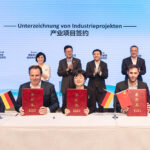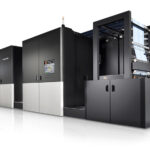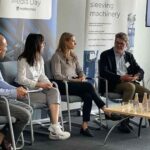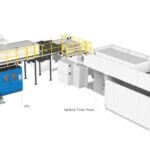370 participants, talks on crucial issues in printing and preprinting, innovative products, a leap forward in international relations, the BestInFlexo award… News from Flexo Day 2015.

The latest Flexo Day was called “A Flexo for All” and was organized by ATIF (Italian Technical Association for Flexography) on 11 November, with the indispensable support of its sponsors. Benefiting from the first ever BestInFlexo award, presented the previous night during a lively gala dinner, the flexographic operators’ conference was marked by its international scope and public bigger than ever before in attendance. This is also because flexographic printing continues to grow and is always finding new fields of application, and because Flexo Day offer useful information for technical, management and market areas, making it an event not to miss.
Asia, Europe and the “chicken average”
The market data cited by president Sante Conselvan in the conference’s opening address forecast many growth opportunities for this technology, in flexible packaging, but also for biomedical products, tissues, furniture and much more. According to official statistics, the global packaging market is destined to grow from 800 billion dollars in 2013 to 980 in 2018, at a rate of +4.1% annually, which in reality is the average between Asia’s +6.3%, North America’s +2.3% and Europe’s more modest but still strong +1.3%.
In this context, flexible packaging’s development is driven by many factors, including the rise of materials requiring innovative processes and products, and new forms of packaging (standing bags or pouches, growing by +7% annually, cites Conselvan), with clear repercussions on print quality – as shown by the change from 3/4 colors to 7/8 – and process efficiency, typically in reducing startup times, driven by the general shrinking of runs, now between 0 and 15 minutes for 43% of operators and between 15 and 30 for 47% of them.
Training and internationalization in view of…
ATIF’s president then gave an account of the association’s activities, which are gangbusters on all fronts, starting with its valued professional training offer. The association has the necessary competencies to guarantee on-going training that can be personalized, and updates on technology and management techniques. Moreover, it is part of a network of technical institutes that organize specialized courses, such as offered by Swansea University on printed electronics.
ATIF is also carrying out research activities that have resulted in a new study on flexographic matrices, which was presented at Flexo Day by Mauro Lussignoli and Sergio Molino, and pursuing standardization efforts, an area in which Conselvan announced a renewed commitment at UNI, also in view of upcoming regulatory changes.
Internationalization and networking are topics very important to Conselvan, who has personally dedicated himself to enhancing the visibility of ATIF and its members abroad («with very promising results: we have been contacted from as far as Poland and Australia, and our knowhow is gaining recognition and appreciation»), and to relaunch relations and lobbying activities, also thanks to a cohesive FTA actively pursuing important goals (not by chance currently advised by Conselvan himself). This was confirmed at Flexo Day by the presence of the Belgian Wim Buyle, current vice-president of the European federation, who was invited to act as moderator, in excellent Italian.
Preprinting: focus on matrices
The new ATIF document on flexographic matrices, soon to be published in the Technical Area of the ATIF website, gathers all current knowledge of forming technologies. It is made up of nine chapters explaining: what matrices are and how they are classified; how graphic transfer works; the stages of the process; the physical features and characteristics of the forming material; adjusting the photographic forming process; measurement and control instruments. The ATIF technical committee is already working to develop other similar studies. The next one, on double-sided tapes, will hopefully be ready in time for Flexo Day 2016, and others are under review. Proposed topics include inks and anilox (the association is taking operators’ suggestions). Lussignoli and Molino were followed by Stefano d’Andrea, a pillar of technical training and a clear and effective teacher, gave a succinct but dense talk on the currently available technologies (there are nine of them) for achieving flexo matrices with the famous “flat head dots” that guarantee quality and stability. D’Andrea spoke in his tenor voice about various plate types, photopolymer components and polymerization processes, as well as the role of oxygen and the importance of pre-exposure, then going on to examine the various techniques for achieving a flat dot, with pros and cons and referencing the latest regulations.
A look at North America
In the afternoon, Flexo Day 2015 was in American (with simultaneous translation), with a lively discussion with the representatives of the FTA overseas on trends and growth prospects of flexography, but also on more technical and practical issues of standardization and print quality. Mark Cisternino and Joe Tuccitto (FTA US president and education director, respectively) sketched an economy in recovery, with all the positive indicators, and a packaging industry in good state of health. In the USA, flexible packaging expects to see 4% annual growth for the next 5 years, reaching a value of 25 billion dollars by 2019, driven mainly by the food, pharmaceutical and pet food industries. The two talks centered on data and trends, along with information on US converters and their suppliers, growth policies and facilities. Furthermore, Tuccitto summed up the salient points of the FIRST specifics, which were created to standardize and optimize flexographic processes, along the Flexographic Principles and Practices.
These documents, which are sure to offer many points for comparison and exchange with those developed by ATIF and FTA Europe, are now an essential reference for the US flexographic industry. The latest editions have been updated to reflect the latest international regulations and methods for printing in the extended 7 color gamut.
Product news
Taking advantage of their position as main sponsors, BiesSse, ETS International and BST Eltromat presented to operators their latest products, offering technological and management updates.
• Angela Conti, BiesSse head of sales for Italy, Europe and Africa, gave an exclusive preview of the characteristics of a new solution for automatically applying adhesive tape and plate, designed and developed by the concern’s Equipment Division (see the article at page 35). Called TPMM, it combines in a single machine all mounting operations normally performed by hand, guaranteeing precision, consistency and performance: it measures the sleeves, removes the liner, cuts and mounts the tape, mounts the plate and performs a final check.
Conti examined all the problems and critical areas of the various operations and explained how the BiesSse engineers dealt with them, garnering interest from the audience.

• Alberto Cantamessa demonstrated the latest direct laser incision and digital flexo matrix developed by Hell Gravure System and marketed by ETS International (photo 2). Distinguishing features: a fiber laser with power range equal or above 600 W, an acousto-optic modulator (AOM) gathers all the 3D data and manages the range, 3D incision (extremely precise) of each single dot, and a resolution between 2540 and 5080 dpi. The audience approved.
• Representing BST Eltromat International, PM Christopher Kauczor illustrated the state of the art of spectrophotometric control. His presentation focused in particular on a modular system (whose components can be assembled as needed) that combines 100% full inspection with color measurement. Based on a single platform and a single operator interface, it is managed by an integrated workflow that simplifies communication with the ink lab, cylinder protocol, preprinting connection and production data and reports.

Why a European FTA?
FTA Europe, which currently comprises the Italian, Spanish, British, Benelux, French and Danish flexographic associations, was founded in 2015 thanks to the initiative and enthusiasm of ATIF. Based in Belgium in the offices of Intergraf (a body representing the European print and media industries), the new association demonstrates its purpose and remarkable potential though a work plan inspired by five major objectives:
– to foster synergies to enable sharing knowledge and resources;
– aligning programs and enabling concerns to join multiple national associations;
– harmonizing competencies;
– developing education, standardization, research and testing activities;
– directing voices and resources on matters of common interests, such as lobbying, fundraising and issuing licenses on materials produced within the federation.
Sante Conselvan mentioned a few projects, at once basic and with wide scope, which will set the tone of “his” 2015-18: from the all-important FTA website going up to a European CV for flexo printing professionals, and from the deployment of “mixed” work groups to the promotion of the European Flexo Award 2016, and joint efforts with universities and other FTAs across the globe (as seen at Flexo day 2015).
Flexo Day 2015: sponsor
BiesSse (Platinum Sponsor); BST Eltromat, ETS International (Gold Sponsor); 3M, AV Flexologic, Edigit, Fujifilm, I&C, Inglese, Lohmann, Mavigrafica, Omet, Simonazzi, Tadam, Tesa, Ulmex, Uteco
(Silver Sponsor)













